| CHAPTER IV: BOOK-MAKING AND COLLECTING IN THE RELIGIOUS
HOUSES Old English libraries; the making, collection and use of books during the middle ages | ||
4. CHAPTER IV: BOOK-MAKING AND COLLECTING IN THE RELIGIOUS HOUSES
1. § I
Piers Plowman, B. x. 300
BEFORE leaving the subject of monastic libraries, it is desirable to say something about their economy.
They were built up partly by importing books, partly by bequests from wealthy ecclesiastics, but largely—and in some cases wholly—by the labours of scribes. The scene of the scribe's craft was the scriptorium or writing-room, which was usually a screened-off portion of the cloister, or a room beside the church and below the library, as at St. Gall, or a chamber over the chapter-house, as at St. Albans under Abbot Paul, at Cockersand Abbey and Birkenhead Priory. As a rule the monk was not allowed to write outside the scriptorium, although in some houses he could read elsewhere—as at Durham, where a desk to support books was fitted in the window of each dormitory cubicle. But brothers whose work was highly valued were allowed a small writing-room or scriptoriolum. Nicholas, Bernard's secretary, had a room on the right of the cloister with its
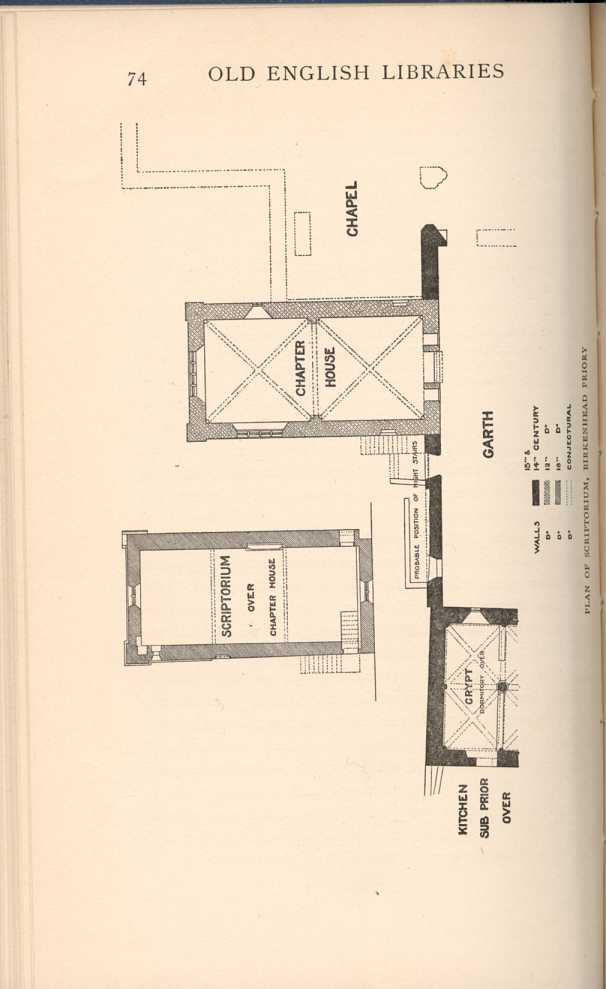 [Description: PLAN OF SCRIPTORIUM, BIRKENHEAD
PRIORY]
[Description: PLAN OF SCRIPTORIUM, BIRKENHEAD
PRIORY]The arrangements in the cloister are carefully described in the Durham Rites. At Durham "in the north syde of the cloister, from the corner over against the church dour to the corner over againste the Dortor dour, was all fynely glased, from the highs to the sole within a litle
The Carthusian Rule records that few monks of the order could not
write.[4.8] But this was by no means
invariably the case. In early monastic times writing was usually the
occupation of the weaker brethren: for example,
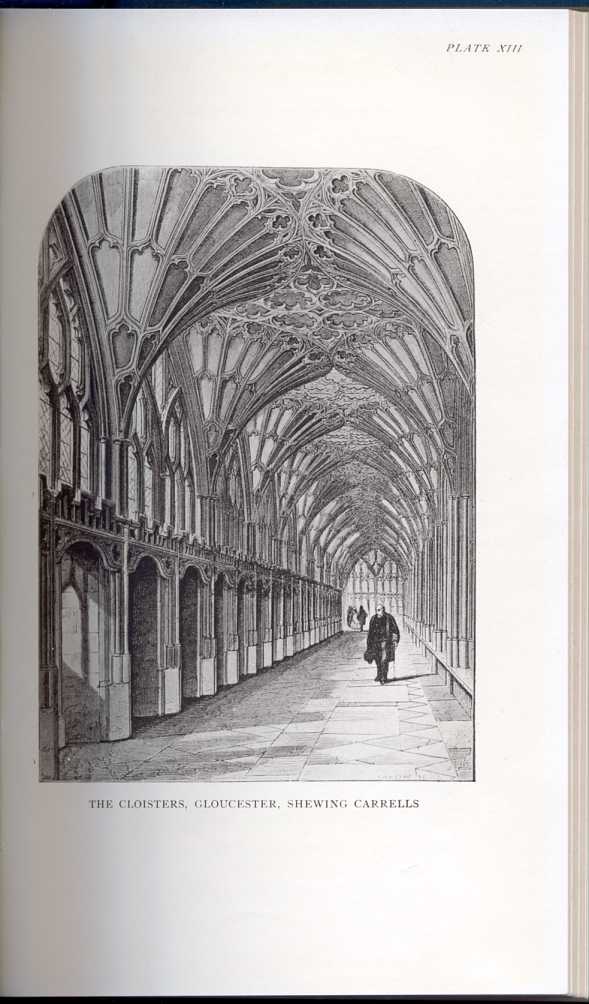 [Description: THE CLOISTERS, GLOUCESTER, SHEWINCG
CARRELLS]
[Description: THE CLOISTERS, GLOUCESTER, SHEWINCG
CARRELLS]
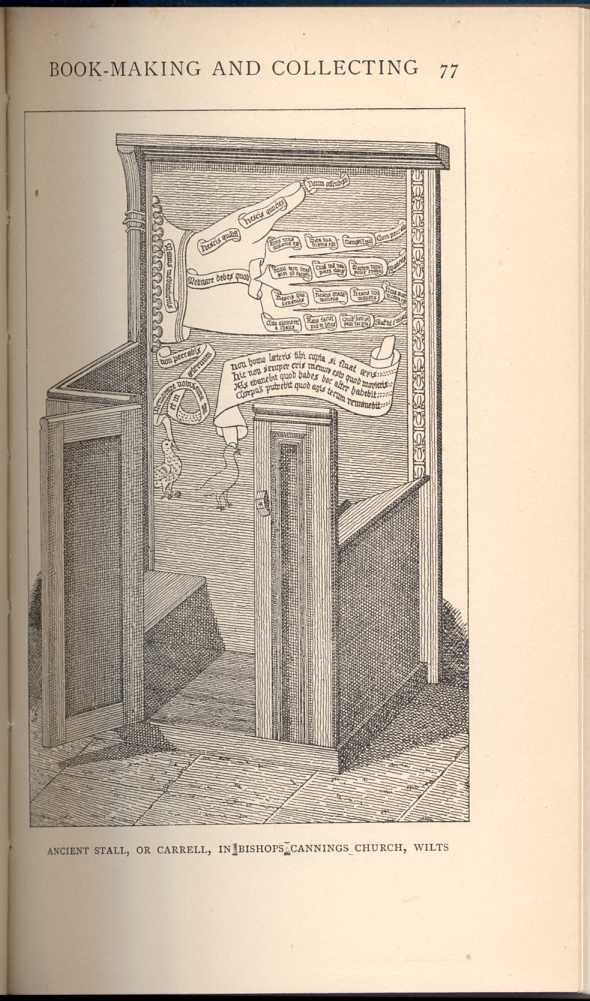 [Description: ANCIENT STALL, OR CARRELL, IN BISHOP
CANNINGS CHURCH, WILTS]
[Description: ANCIENT STALL, OR CARRELL, IN BISHOP
CANNINGS CHURCH, WILTS]When books were not otherwise obtainable, or not obtainable quickly enough, it was the practice to hire scribes from outside the house. Abbot Gerbert, in a letter to the abbot of Tours, mentions that he had been paying scribes in Rome and various parts of Italy, in Belgium, and Germany, to make copies of books for his library "at great expense."[4.11] At Abingdon hired scribes were sometimes employed, and the rule was for the abbot to find the food, and the armarius, or librarian, to pay for the labour. [4.12] This was commonly done when libraries were first formed. When Abbot Paul began to collect a library at St. Albans none of his brethren could write well enough to suit him, and he was obliged to fill his writing-room with hired scribes. He supplied them with daily rations out of the brethren's and cellarer's alms-food; such provision was always handy, and the scribes were not retarded by leaving their work.[4.13] Sometimes scribes were employed merely to save the monks trouble. At Corbie, in the fourteenth century, the religious neglected to work in the writing-room themselves, but allowed benefactors to engage professional scribes in Paris to swell the number of books. The Gilbertine order forbade hired scribes altogether, perhaps wisely.
The scribe's method of work was simple. First he;: took a metal
stylus or a pencil and drew perpendicular lines in the side margins of
his parchment, and horizontal lines at equal distances from top to
bottom of the page. Then the task of copying was straightforward. If
the book was to be embellished he left spaces for the illuminator to
fill in. When the illuminator took the book over, he carefully sketched
in his designs for the capitals and miniatures, and then worked over
them in colour, applying one colour to a number of sketches at a time.
Anybody who is curious as to medieval methods of illuminating should
read a little fifteenth-century treatise which describes "the crafte of
lymnynge of bokys." "Who so kane wyesly considere the nature of his
colours, and kyndely make his commixtions with naturalle proporcions,
and mentalle indagacions connectynge fro dyvers recepcions by resone of
theyre naturys, he schalle make curius colourys." Thereafter follow
recipes to "temper vermelone to wryte therewith"; "to temper asure,
roses, ceruse, rede lede," and other pigments; "to make asure to schyne
 ," "to make letterys of
gold," "blewe lethyre," and "whyte lethyre"; with other curious
information. [4.14]
," "to make letterys of
gold," "blewe lethyre," and "whyte lethyre"; with other curious
information. [4.14]
In monasteries where the rule was strict the scribe wrought at his task for six hours daily.[4.15] All work was done by daylight, artificial light not being allowed. Lewis, a monk of Wessobrunn in Bavaria, in a copy of Jerome's Commentary on Daniel, speaks of writing when he was stiff with cold, and of finishing by the light of night what he could not copy by day. [4.16] Such diligence was not usual.
In summer-time work in the cloister may well have
A scribe could only write what the abbot or preceptor set him. When his portion had been given out he could not change it for another.[4.19] If he were set to copy Virgil or Ovid or some lives of the saints the task would conceivably be pleasant. But such was seldom the scribe's fortune. The continual transcription of Psalters and Missals and other service books must have been infinitely wearisome, at any rate, to the less devout members of the community. In some large and enterprising houses a scribe copied only a fragment of a book. Several brethren worked upon the same book at once, each beginning upon a skin at the point where another scribe was to leave off.[4.20] Or the book to be transcribed was dictated to the scribes, as at Tours under Alcuin. Both methods had the advantage of "publishing" a book quickly, but the work was as
When a manuscript was fully written the scribe wrote his colophon or "explicit," a short form of the phrase "explicitus est fiber." Sometimes the scribe plays upon words, thus: "Explicit iste liber; sit scriptor crimine liber"; or he exultantly praises: "Deo gratias. Ego, in Dei nomine, Warembertus scripsi. "Deo gratias"; or he is modest: "Nomen scriptoris non pono, quia ipsum laudare nolo"; [4.21] or he feels querulous: "Be careful with your fingers; don't put them on my writing. You do not know what it is to write. It is excessive drudgery: it crooks your back, dims your sight, twists your stomach and sides. Pray then, my brother, you who read this book, pray for poor Raoul, God's servant, who has copied it entirely with his own hand in the cloister of St. Aignan." Another inscription, in a manuscript at Worcester Cathedral, suggests that books were not read: why, argues this monk, write them?—nobody is profited; books are for the edification of readers, not of scribes. Note also the following:—
Vinum scriptori debetur de meliori
Hic liber est scriptus qui scripsit sit benedictus. Amen.[4.22]
whyche fallen moste commune and withe þe grace of gode I
will writte þe ij Boke þe whyche ys cleped the Antitodarie
Explicit quod scripcit Thomas Rosse.[4.23]
To a poor Raoul of mechanical ability the rule of silence must
have been very irksome; the student would be grateful for it. Alcuin
forbade gossip to prevent mistakes in copying. Among the Cluniacs the
rule was strictly enforced in the church, refectory, cloister, and
dormitory. A chapter of the Cistercian order (1134) enjoined silence in
all rooms where the brethren were in the habit of writing.
[4.24] The better to maintain silence nobody was
permitted to enter the scriptorium save the abbot, the prior and
sub-prior, and the preceptor. When necessary it was permissible to speak
in a low voice in the ear; But among the Cluniacs whispering was avoided
as far as possible. Watch the monks communicating with the librarian.
One wants a Missal, and he pretends, as the children say, to turn over
leaves, thereby making the general sign for a book; then he makes the
sign of the Cross to indicate that he wants a Missal book. Another wants
the Gospels, and he makes the sign of the Cross on the forehead. This
brother wants a pagan book, and, after making the general sign, he
scratches his ear with his finger as an itching dog would with his feet;
infidel writers were not unfairly compared with such creatures.
[4.25] If such sign-language were really
maintained, it must have been extensively supplemented as the library
grew in size, for although striking the thumb and little
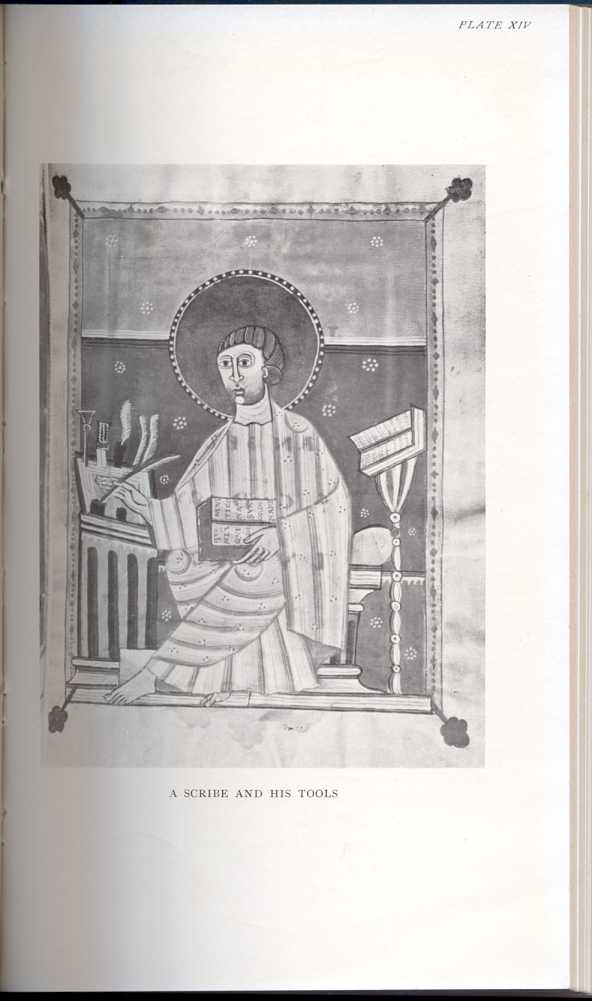 [Description: A SCRIBE AND HIS TOOLS]
[Description: A SCRIBE AND HIS TOOLS]
For notes, exercises, brief letters, bills, first drafts, daily, services of the church, the names of officiating brethren,— for all temporary purposes waxed tablets were used. They were in common use from classic times: some Greek and many Latin tablets are still preserved;[4.27] they were much used in ancient Ireland, as we have seen; and they continued to be of service until the late Middle Ages. Anselm habitually wrote his first drafts upon them. At St. Augustine's Abbey, Canterbury, the monks were supplied with tablets, for a novice's outfit included, after profession, a stylus, tablets, and a knife.[4.28] The writing was scratched on the wax with a stylus, a sharp instrument of bone or metal. The other end of it was usually flattened for pressing out an incorrect letter; among the Romans the term "vetere stylum" became common in the sense of correcting a work.
For all permanent purposes "bōc-fel," or book-skin, was
used; either vellum or "parchëmyn smothe, whyte and scribable."
Vellum and parchment were interchangeable terms in medieval times; but
parchment was commonly used. In early monastic days it was prepared by
the monks themselves, being rubbed smooth with pumice-stone;
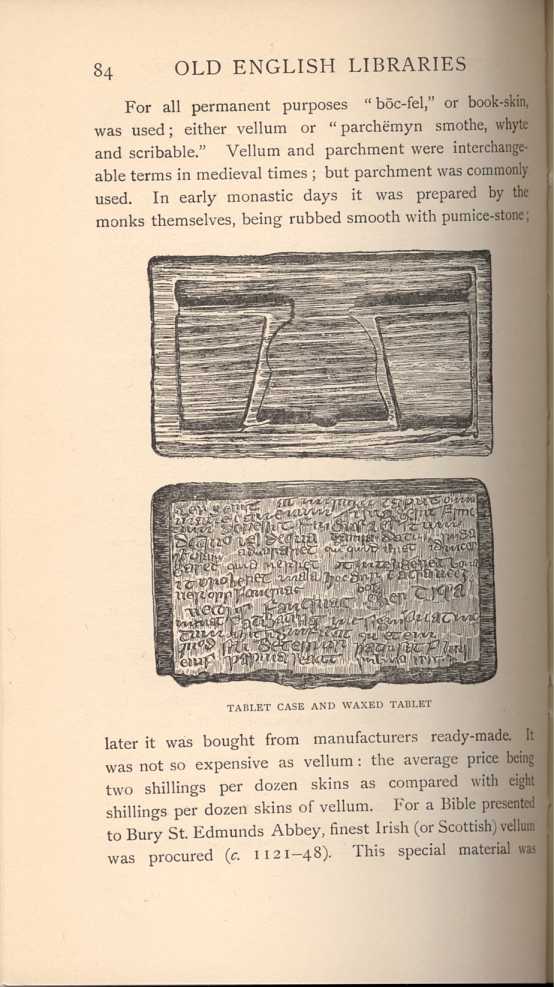 [Description: TABLET CASE AND WAXED
TABLET]
[Description: TABLET CASE AND WAXED
TABLET]
The pens used for writing were either made of reeds (calami) or of quills (pennae). The quill was introduced after the reed, and largely, though not entirely, superseded it. Other implements of the expert scribe were a pencil, compasses, scissors, an awl, a knife for erasures, a ruler, and a weight to keep down the vellum.
Numerous passages might be dug out of old records warning scribes against errors in transcribing. Ælfric, in the preface to his homilies, adjures the copyist, by our Lord Jesus Christ and by His glorious coming, to transcribe correctly. Chaucer, in a well-known verse, expresses his wish that Adam the scrivener shall copy Boëthius and Troilus "trewe" and not write it "newe."[4.30] In copying, however, especially when it is mechanically done, it is almost as difficult to write "trewe" as it is to write "newe": the imp of the perverse makes his home at the elbow of the scribe, ever ready to profit by drowsiness or trifling inattention. But, as a rule, monkish scribes were exceedingly careful, and their work was invariably corrected by another hand. More than this: they endeavoured to get accurate texts to copy. Lanfranc's care in this respect, and the Grey Friars' work in compiling correctoria, have already been noted. Reculfus expected his clergy to have books corrected and pointed by those in the "holy mother church"; Adam de Marisco sent a manuscript to be corrected in Paris, begging to have it back as soon as done; [4.31] and Servatus Lupus, the great abbot of Ferrières, frequently borrowed from his friends books which he might collate with his own copies, and rectify errors and insert omissions.[4.32]
Before work could be started in the writing-room, books for copying had to be obtained. Usually a few books were bought or borrowed; then several copies were made of each, the superfluous volumes being sold or exchanged for fresh manuscripts to transcribe. Benedict Biscop, as we have seen, obtained his books from Rome and Vienne. Cuthwin, bishop of the East Angles (c. 750) was of those who went to Rome, and brought back with him a life of St. Paul, "full of pictures." Herbert "Losinga," abbot of Ramsey and afterwards bishop of Norwich, was a zealous book-collector;—asks for a Josephus on loan from a brother abbot, a request not granted because the binding needed repair; and sends abroad for a copy of Suetonius. Robert Grosseteste got a rare book, Basil's Hexaemeron, from Bury St. Edmunds in exchange for a MS. of Postillae.[4.33] At Ely, in the fourteenth century, when the scribes there were very active, the preceptor was always on the look-out for "copy." On one occasion he was paid 6s. 7d. for going to Balsham to inquire for books (1329). [4.34] Abbot Henry of Hyde Abbey exchanged a volume containing Terence, Boëthius, Suetonius, and Claudian for four Missals, the Legend of St. Christopher, and Gregory's Pastoral Care.[4.35] On one occasion Adam de Marisco tries to get from a brother of Nottingham the Moralia of St. Gregory, and Rabanus Maurus. He sends from Oxford to an abbot at Vercelli an exposition of the Angelic Salutation, and begs for the abbot's writings in exchange. [4.36] Adam had studied at Vercelli, [4.37]—a new Italian centre with a close English connexion. About 1217 Cardinal Guala Bicchieri, afterwards bishop of Vercelli, was granted the church of
In some abbeys the purchase of books, and the copying of them for sale, became just as much a business as the manufacture of Chartreuse. In 1446 Exeter College, Oxford, paid ten shillings and a penny for twelve quires and two skins of parchment bought at Abingdon to send to the monastery of Plympton in Devonshire, where a book was being written for the College.[4.39] A part—and by no means a negligible part—of the income of Carthusian houses came from copying books. Two continental abbots, Abbot Gerbert of Bobio and Servatus Lupus of Ferrières, were book-makers and sellers on a commercial scale. Lupus, in particular, betrays the commercial spirit by refusing to give more than he was obliged in return for what he received. He will not send a book to a monk at Sens because his messenger must go afoot and the way was perilous: let us hope he thought more of the messenger than of the manuscript. On another occasion he refuses to lend a book because it is too large to be hidden in the vest or wallet, and, besides, its beauty might tempt robbers to steal it. These were good excuses to cover his general unwillingness to lend. For the loan of one manuscript he
As a rule the expenses of the writing-room formed a part of the general expenses of the house, but sometimes particular portions of the monastic income and endowments were available to meet them. To St. Albans certain tithes were assigned by a Norman leader for making books (c. 1080).[4.41] The preceptor of Abingdon obtained tithes worth thirty shillings for buying parchment.[4.42] St. Augustine's Abbey, Canterbury, got three marks from the rentals of Milton Church for making books (1144).[4.43] The monks of Ely (1160), of Westminster (c. 1159), of the cathedral convent of St. Swithin's, Winchester (1171), of Bury St. Edmunds, and of Whitby, received tithes and rents for a like purpose. [4.44] The prior of Evesham received the tithes of Bengworth to pay for parchment and for the maintenance of scribes; while the preceptor was to receive five shillings annually from the manor of Hampton, and ten shillings and eightpence from the tithes of Stoke and Alcester for buying ink, colours for illuminating, and what was necessary for binding books and the necessaries for the organ. [4.45]
In some houses a rate was levied for the support of the scriptorium, but we have not met with any instance of this practice in English monasteries. At the great Benedictine Abbey of Fleury a rate was levied in 1103 on the officers and dependent priories for the support of the library; forty-three years later it was extended, and it remained in force
The libraries were also augmented by gifts and bequests, as well as by purchase and by transcription in the scriptorium. In most abbeys it was customary for the brethren to give or bequeath their books to their house. A long list of such benefactors to Ramsey Abbey is extant, and one of the brothers, Walter de Lilleford, prior of St. Ives, gave what was in those days a considerable library in itself. [4.47] Much longer still are the lists of presents given to Christ Church and St. Augustine's, Canterbury. Dr. James has indexed nearly two hundred donors to Christ Church alone. In most cases the gifts are of one or a few books, but occasionally collections of respectable size were received, as when T. Sturey, senior, enriched the library with nearly sixty books, when Thomas à Becket left over seventy, and when Prior Henry Eastry left eighty volumes at his death. As many or more donors to St. Augustine's are indexed. Here also some of the donations were fairly large: for example, Henry Belham and Henry Cokeryng gave nineteen books each, a prior twenty-seven, a certain John of London eighty-two, J. Mankael thirty-nine, Abbot Nicholaus sixteen, Michael de Northgate twenty-four, Abbot Poucyn sixteen,
William de Carilef, bishop of Durham, endowed his church with books and bequeathed some more at his death (1095). John, bishop of Bath, bequeathed to the abbey church his whole library and his decorated copies of the Gospels (1160). Another bishop of Durham, Hugh Pudsey, bequeathed many books to his church (1195). Thomas de Marleberge (d. 1236), when he became prior of Evesham, gave a large collection of books in law, medicine, philosophy, poetry, theology, and grammar.[4.49] Simon Langham bequeathed seven chests of books to Westminster Abbey (1376). [4.50] William Slade (d. 1384) left to the Abbey of Buckfast, of which he was abbot, thirteen books of his own writing.[4.51] Cardinal Adam Easton (d. 1397) sent from Rome "six barrells of books" to his convent of Norwich, where he had been a monk.[4.52] One of these books, a fourteenth-century manuscript in an Italian hand, is now preserved in the library of Corpus Christi College, Cambridge: the inscription attesting this reads—"Liber ecclesie norwycen per magistrum Adam de Eston monachum dicti loci." Nor did the poor priest forget to add his mite to the general hoard: "I beqweth to the monastery of Seynt Edmund forseid," willed a priest named Place, "my book of the dowses of Holy Scryptur, to ly and remayn in the cloister of the seid monastery as long as yt wyll ther indure." [4.53] Such gifts were always highly valued, and in Lent the librarian was
2. § II
Some miniatures in early manuscripts give us a good idea of the way books were stored in the Middle Ages. They are shown lying flat on sloping shelves which extend part-way round the room. Curtains are occasionally shown hanging in front of the shelves to protect the books from dust. Or a sloping shelf was fitted to serve as a reading-desk, and a second flat shelf ran beneath it to take books lying on their sides one above the other. In several miniatures lecterns of very curious design are often depicted; some of them stood on a cupboard or cupboards wherein books were stowed away.
In the monasteries books were stored in various places, —in chests, cupboards, or recesses in the wall. When the collection was small, a chest served; a receptacle of this kind is illustrated at p. 50. Cassiodorus had the books of his monastery stored in presses, or armaria. The manuscripts of Abbot Simon of St. Albans were preserved in "the painted aumbry in the church." An aumbry was a recess in the wall well lined inside with wood so that the damp of the masonry should not spoil the books. It was divided vertically and horizontally by shelves in such a way that it was possible to arrange the books separately one from al other, and so to avoid injury from close packing, and delay in consulting them.[4.55] The same term was applied to a detached closet or cupboard. At Durham the monks distributed their books—keeping some in the spendimentum or cancellary, some near the refectory, and
Along the south wall of the cloister at Chester is a series of recesses which are believed to have been used for bookcases. Two recesses for aumbries are still to be seen in the cloister at Worcester: it is recorded that one book,
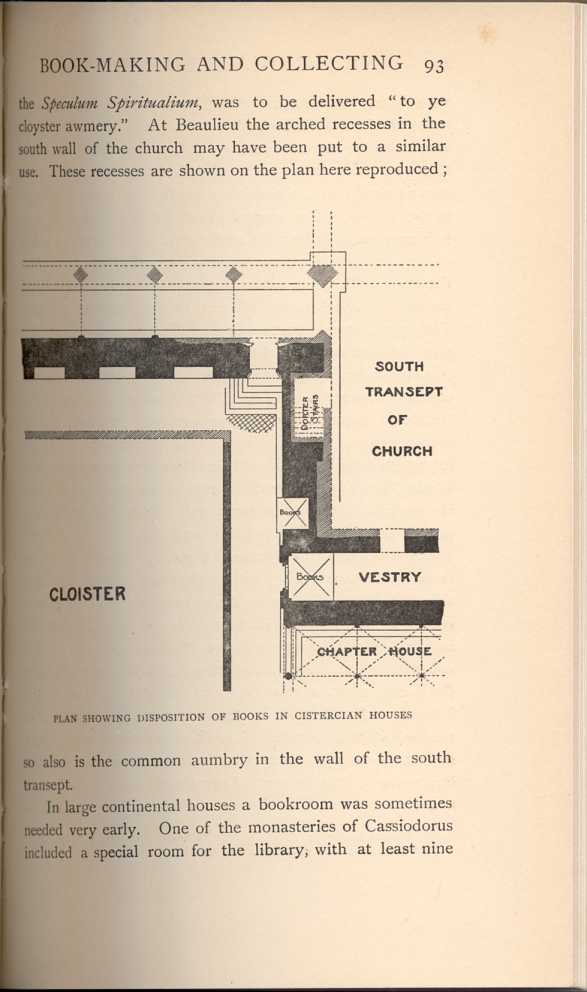 [Description: PLAN SHOWING DISPOSITION OF BOOKS IN
CISTERCIAN HOUSES]
[Description: PLAN SHOWING DISPOSITION OF BOOKS IN
CISTERCIAN HOUSES]In large continental houses a bookroom was sometimes needed very early. One of the monasteries of Cassiodorus included a special room for the library, with at least nine
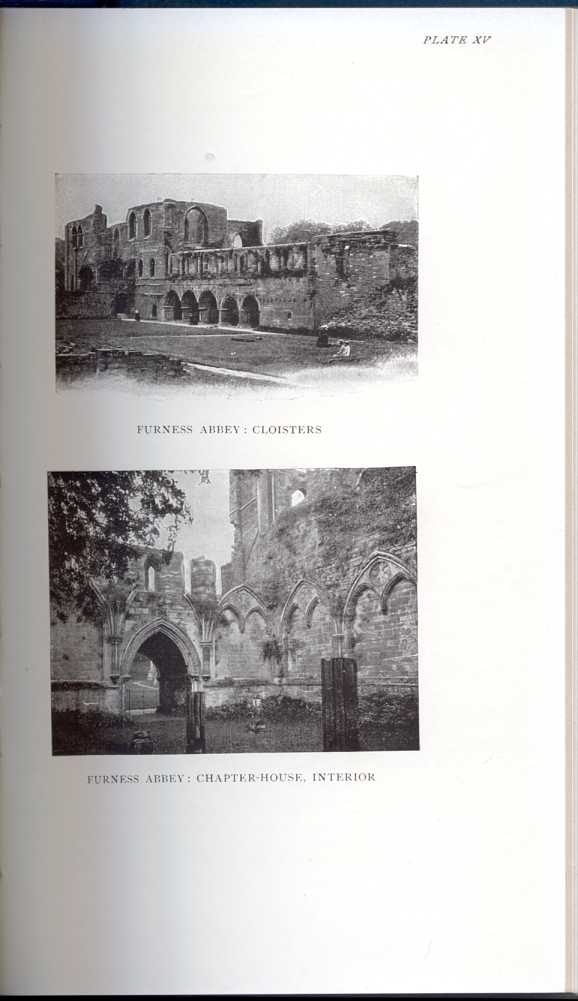 [Description: FURNESS ABBEY: CLOISTERS;
FURNESS ABBEY: CHAPTER-HOUSE, INTERIOR]
[Description: FURNESS ABBEY: CLOISTERS;
FURNESS ABBEY: CHAPTER-HOUSE, INTERIOR]At the Premonstratensian Abbey of Titchfield the books were stored in a small room, in four cases, each having eight shelves. We do not positively know that a separate room existed at the Benedictine house of Christ Church, Canterbury, before the fifteenth century, "yet," as Dr. James says, "the form of Prior Eastry's catalogue, with its division into Demonstrations and Distinctions, irresistibly suggests that the collection must in his time [1284-1331] have occupied a special room, of which the two Demonstrations represent the two sides. The Distinctions would be narrow vertical divisions of these, and each of them would have its numerous subdivisions into Gradus. As the best English equivalent of Demonstratio I would suggest the word `Display,' which fairly gives the idea of a wall-surface covered with books; and I figure the building to myself as an enlarged example of those Cistercian bookrooms with which Dr. J. W. Clark's researches have familiarized us. It would thus be no place for study, such as the later libraries were, but merely a storeroom whence books were fetched to be read at leisure in the cloister."[4.62] Between 1414 and 1443 a library was built over the Prior's Chapel by Archbishop Chichele: it was about sixty-two feet long on the north side, fifty-four on the south side, and twenty-two feet broad. This was the room which Prior Selling fitted up with wainscot, and put books in for the benefit of the studious.[4.63] At St. Augustine's Abbey, Canterbury, there was a bookroom in 1340, for the manuscript of the Ayenbite of Inwyt contains a note that it belongs to the
At Gloucester a special room was built, probably in the fourteenth century. Durham apparently did without a room until early in the fifteenth century. "There ys a lybrarie in the south angle of the lantren, whiche is nowe above the clocke, standinge betwixt the Chapter-House and the Te Deum wyndowe, being well replenished with ould written Docters and other histories and ecclesiasticall writers." [4.65] To this room the books were transferred gradually from the cloister and chancellery: the words "in libraria," or "Ponitur in libraria," being written in the margin of the catalogue opposite to the book upon its removal.
The Benedictine houses of Winchester, Worcester, Bury St. Edmunds,[4.66] and St. Albans also had special bookrooms.
For the safe keeping of the conventual books the preceptor was responsible.[4.67] As he had charge of the armarium or press for storing books, he was also sometimes styled "armarius." He was required to keep clean all the boys' and novices' presses and other receptacles for books; when necessary he was to have these fittings repaired. To provide coverings for the books; to see that they were marked with their proper titles; to arrange them on the shelves in suitable order, so that they might be quickly found, were all duties within his province.[4.68] He had to keep them in repair: in some houses he was expected to
As a rule the monks so highly prized their books— saving them first, for example, in time of danger, as when the Lombards attacked Monte Cassino and the Huns St. Gall—that rules for the care of them would seem almost superfluous. Still, such rules were made. When reading, the monks of some houses were required to wrap handkerchiefs round the books, or to hold them with the sleeve of their robe. Coverings, perhaps washable, were put upon books much in use. [4.71] The Carthusian brethren were exhorted in their statutes to take all possible care to keep the books they were reading clean and free from dust.[4.72] Elsewhere we have referred to an "explicit" urging readers to have a care for the scribe's writing: in another manuscript once belonging to Corbie, the kind reader is bidden to keep his fingers off the pages lest he should mar the
3. § III
One of the preceptor's chief duties was to regulate lending books. At Abingdon he could only lend to outsiders upon a pledge of equal or greater value than the book required, and even so could only lend to churches near by and to persons of good standing. It was deemed preferable to confiscate the pledge than to proceed against a defaulting borrower. In some houses more than a pledge was demanded if the book were lent for transcription, the borrower being required to send a copy when he returned the manuscript. "Make haste to copy these quickly," wrote St. Bernard's secretary, "and send them to me; and, according to my bargain, cause a copy to be made for me. And both these which I have sent you, and the copies, as I have said, return them to me, and take care that I do not lose a single tittle." [4.74] The extra copy was demanded, not so much for purposes of gain as to put a check upon borrowing, a practice which many abbots did not encourage, on account of the danger of loss. Books, like gloves, are soon lost. We can well understand how uncommonly easy it was to forget to return a coveted manuscript. To help borrowers to overcome the insidious temptation, the scribe sometimes wrote upon the manuscript the name of the monastery it belonged to, and threatened a defaulter with anathema. In some of the St. Albans' books is the following note in Latin: "This book is St. Alban's book: he who takes it from him or destroys the title be anathema." [4.75]
A similar thing took place in Scotland (1331). A friar of Roxburgh forsook his grey habit for the Cistercian white by entering Kelso Abbey. He made his new associates
The prior and convent of Ely traced some of their books to Paris. They wrote to Edward III (1332): "Because a robber has taken out of our church four books of great value, viz.—The Decretum, Decretals, the Bible and Concordance, of which the first three are now at Paris, arrested and detained under sequestration by the officer of the Bishop of Paris, whom our proctor has often prayed in form of law to deliver them, but he behaves so strangely that we shall find in him neither right, grace, nor favour:— We ask you to write to the Bishop of Paris to intermeddle favourably and tell his official to do right, so that we may get our things back."[4.82] In 1396-7 William, prior of Newstead, and a brother canon, proceeded against John Ravensfield for the return of a book by Richard of Hampole, entitled Pricke of Conscience, "and now the parties aforesaid are agreed by the licence of the court, and the said John is in `misericordia'; he paid the amercement in the hall."[4.83] Another record tells us of two monks of Christ Church, Canterbury, being sent into Cambridgeshire to recover a book.
The risk of loss owing to the practice of lending books was great—how great may be judged from the fact that of the equal portions of the Peterhouse College library of 1418, 199 volumes of the chained portion remain, but only ten of all those assigned to the Fellows are left.[4.84] In spite of the risk, lending was extensively carried on.
Lending books to brethren in the monastery was conducted according to strict rules, of which those of Lanfranc, based on the Cluniac observances, afford a good example. Before the brethren went into chapter on the Monday after the first Sunday in Lent, the librarian laid out on a carpet in the chapter-house all the books which were not on loan. After the assembly of the brethren, the librarian read his register of the books lent to the monks. Each brother, on hearing his name, returned the book which had been entrusted to him. If he had not made good use of the book, he was expected to prostrate himself, confess his neglect, and beg forgiveness. When all books were returned, others were issued, and a new record made. In some monasteries the abbot would question the monks on
Among the Cluniacs it was the custom to take stock of the books given out to the monks once a year; while the Franciscans kept a register of their books, and every year it was read and corrected before the convent in assembly.[4.89]
An excellent example of a stocktaking record made at Christ Church, Canterbury, has been preserved. The inspection took place in 1337. First are recorded the books missing from the two "demonstrations," as recorded "in magnis tabulis," e.g.,
Primo: deficit liber Transfiguratus in Crucifixum, ad
quem est in nota Frater W. de Coventre. Nineteen books were missing from the two "demonstrations," or displays. Nineteen service books were missing "in parvis tabulis." No less than thirty-eight books, twenty-eight of them for service, either of the large or the small tables, were wanting: for these deceased brethren had been responsible.[4.90]
The "large tables" are believed to be boards whereon the borrowers of books had their names and borrowings noted. "I find," writes Dr. James, "in a St. Augustine's manuscript a note written on the fly-leaf by a monk, of the books `pro quibus scribor in tabula'—`for which I am down on the board.' "[4.91] Large tables were in use at
Besides the example of an audit at Canterbury we have one belonging to Durham, a little later in date (1416). The list of books assigned to the Spendement was evidently read over, and a tick or point was put against every volume found in its place. On a second check certain books were accounted for, and notes of their whereabouts were added to the inventory. Some were found in the cloister, others were in the library; the prior of Finchale had a number; many had been sent to Oxford. In one case a book is noted as given to Bishop Kempe of London.[4.93]
The catalogue was usually a simple inventory. Sometimes the entries were classified, as in the case of a catalogue of the York library of the Friars Eremites of the Augustinian order. The fifteenth-century catalogue of St. Augustine's, Canterbury, is classified under sixteen headings, but it is probably incomplete. [4.94] As a rule the entries were only just sufficient to identify the books: all the treatises in a volume were not often recorded, but only the title of the first. This is an entry from a Durham catalogue:—
Februaria et Marcii. II. fo., non surrexerunt.
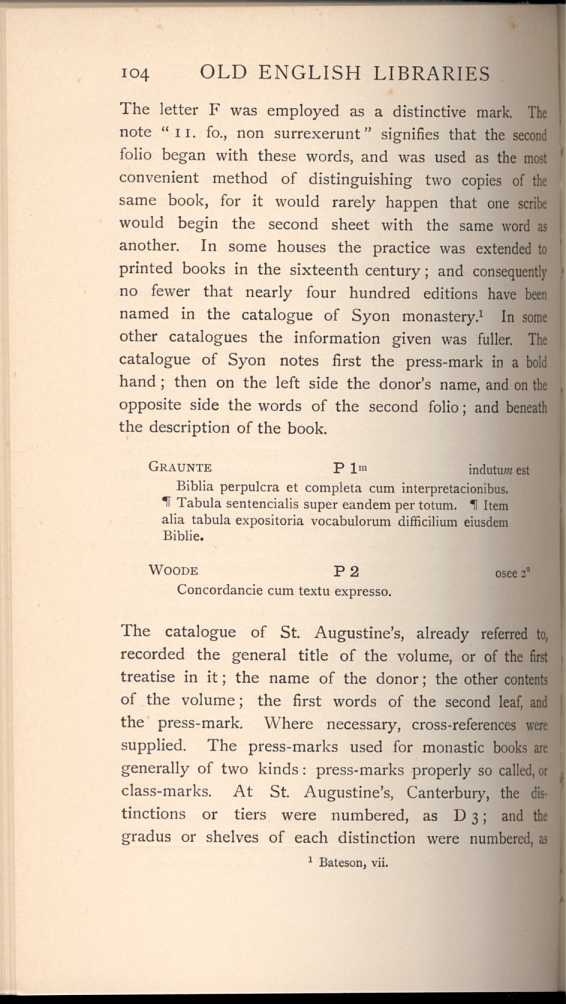 [Description: The Catalogue of Syon
information on printed books]
[Description: The Catalogue of Syon
information on printed books]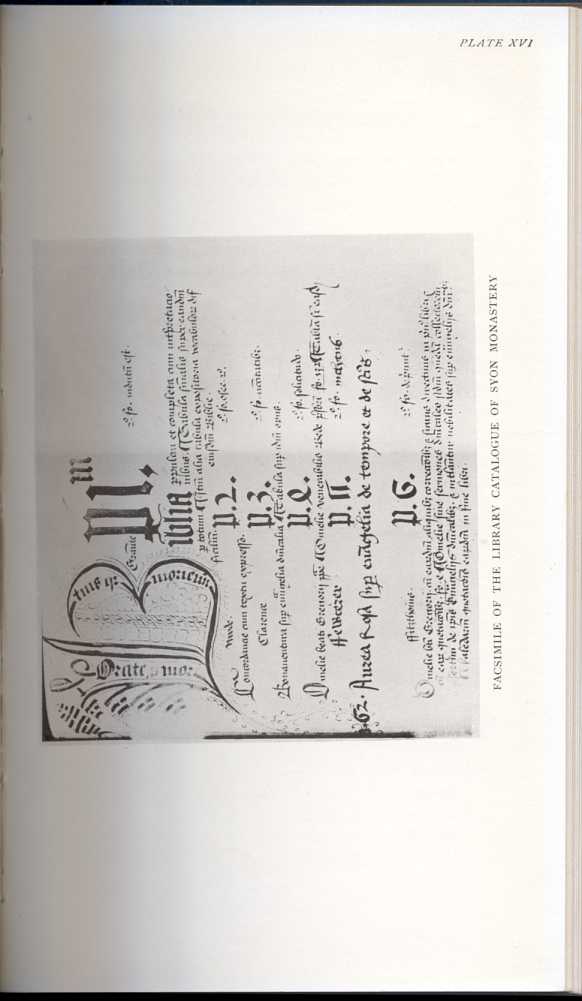 [Description: FACSIMILE OF THE LIBRARY CATALOGUE OF
SYON MONESTERY]
[Description: FACSIMILE OF THE LIBRARY CATALOGUE OF
SYON MONESTERY]The most elaborate example of monkish cataloguing comes from Dover Priory, a cell belonging to Canterbury. One John Whytefield compiled it in 1389. The note preceding the catalogue tells of unbounded enthusiasm for the library and a meticulous regard for order. No better proof of the care taken of books by most monks could be found. The catalogue is in three parts. First there is a brief inventory of the books as they are arranged on the shelves. This is a shelf-list designed for the use of the preceptor; just the sort of record modern librarians regard as indispensable in the administration of their libraries. Secondly, our industrious monk has provided a catalogue, —a repetition of the shelf-list, but with all the contents of each volume set out. His chief aim in making this compilation is to show up fully the resources of his collection, and to lead studious brethren to read zealously and frequently. Lastly, an analytical index to the
| Ordo locacionis. | Nomina voluminum. | Loca probacionum. | Dicciones probatorie. | Summa ffoliorum. | Numerus contentorum. |
| 1 | Psalterium vetus glosatum | 6 | apprehendite disci | 105 | 1 |
| 2 | Prima pars psalterii glosata gallice | 4 | cument que il lait | 195 | 2 |
| 3 | Glose super spalterio | 6 | nullas habebunt veri | 104 | 2 |
Most books were bound by the monks themselves. The commonest materials used for ordinary manuscripts were wooden boards, covered with deerskin and calfskin, either coloured red or used in its natural tint, and parchment usually stained or painted red or purple. Charles the Great authorised the Abbot of St. Bertin to enjoy hunting rights so that the monks could get skins for binding. In mid-ninth century, Geoffroi Martel, Count of Anjou, commanded that the tithe of the roeskins captured in the island of Oléron should be used to bind the books in an abbey of his foundation. Few monastic bindings have been preserved, because many great collectors have had their manuscripts rebound. Several examples of Winchester work remain. Mr. Yates Thompson has a mid-twelfth century manuscript bound in the monastic style, the leather being stamped with cold irons of many curious rectangular shapes. The manuscript of the Winton Domesday has a binding with stamps exactly like those on Mr. Thompson's book. "At Durham in the last half of the twelfth century there was an equally important school of binding, with some one hundred and fourteen different stamps. The binding for Hugh Pudsey's Bible has nearly five hundred impressions." [4.100] In Pembroke College library an excellent specimen of twelfth century stamped binding remains on MS. 147. Such stamps were small, and frequently of geometrical or floral design, always rudimentary; but
If a book was specially prized the binding was often rich. The covers of the Gospels of Lindau, a superb example of Carolingian art, bear nearly five hundred gems encrusted in gold. [4.101] Abbot Paul of St. Albans gave to his church two books adorned with gold and silver and gems. Abbot Godfrey of Malmesbury, partly to meet a heavy tax imposed by William Rufus, stripped twelve Gospels of their decorations. "Books are clothed with precious stones," cried St. Jerome, "whilst Christ's poor die in nakedness at the door."[4.102] In spite of the many references to jewelled monastic bindings in medieval records, very few are extant.
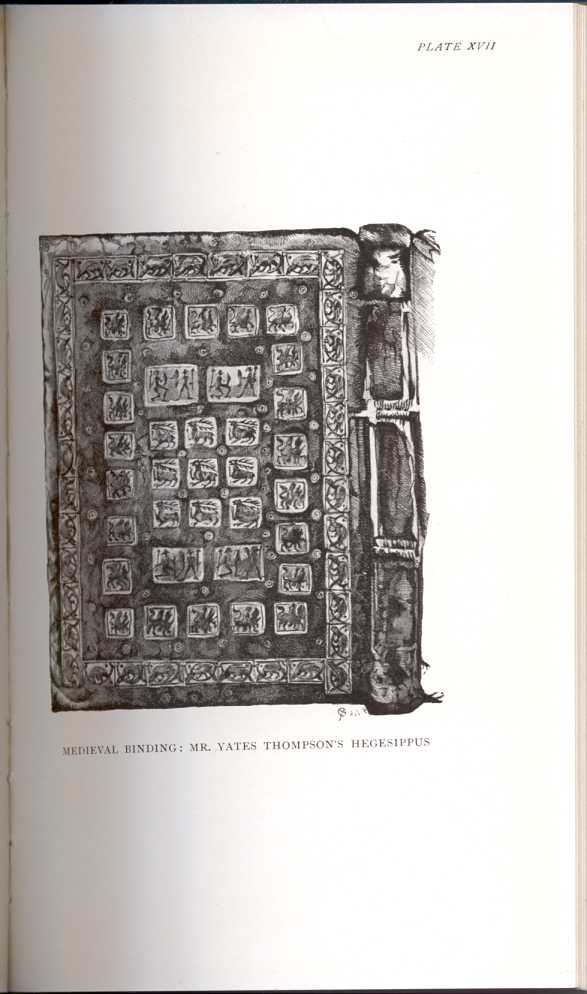 [Description: MEDIEVAL BINDING: MR. YATES THOMPSON'S
HEGEIPPUS]
[Description: MEDIEVAL BINDING: MR. YATES THOMPSON'S
HEGEIPPUS]
From the Porkington MS.; this treatise has been printed in Early Engish Miscellanies, ed. J. O. Halliwell, for the Warton Club (1855), p. 72. Other treatises are in Mrs. Merrifield's Arts of Painting (1849).
Customary of St. A. (H. Brads. Soc.), i. 401. These tablets were called ceratae tabellae, tabellae cerae, or simpty cerae. The name of a book, caudex, codex, was first given to these tabellae when they were strung together to form a square "book." V. Antiquary, xii. 277.
C. A. S. (N.S.), 8vo ser. vii. 187 (1909). The story of the connexion between Chesterton and Vercelli is most interesting. A list of the books is in Lampugnani, Sulla Vita di Guala Bicchieri, Vercelli (1842), 125 et seq.; but I have not been able to see the book. See further Bekynton's Correspondence, ii. 344 (Rolls Ser.); and Kennedy, Poems of Cynewulf (1910), 6.
Chron. mon. de Abingd., ii. 153. A list of the preceptor's rents, applied to expenses of the writing-room and the organ, will be found in ii. 328.
Cam. Soc., Bury Wills (1850), 105. Many of the gifts to Syon monastery came from priests.—Bateson, xxiii-xxvii. Cf. also lists of donors in James (M. R.), 535 et seq.
Surtees Soc. xv., Durham Rites, 70-71. The library would be that built by Wessington in 1446.
MS. Arundel 57, Brit. Mus. See James (M. R. ), lxxvii. "This boc is dan Michelis of Northgate, y-write an englis of his ozene hand. thet hatte: Ayenbyte of Inwyt. And is of the bochouse of Saynt Austines of Canterberi. mid the lettres CC." "Ymende, thet this boc is volveld ine the eve of the holy apostles Symon an Judas, of ane brother of the cloystre of Sanynt Austin of Canterberi, ine the yeare of oure Ihordes beringe (birth) 1340."
C. 1429-45. Most likely over the cloister. The books seem to have been arranged flat on sloping desks, to which they were chained.—James (M. R. )1, 41.
Bateson, 202. Ut scilicet prima particula de numero et perfecta voluminum cognicione loci precentorem informet, secunda ad solicitam leccionis frequenciam ffratres studiosos provocet, et tercia de singulorum tractatuum repercione festina scolaribus itinera manifestet.—James, 407.
| CHAPTER IV: BOOK-MAKING AND COLLECTING IN THE RELIGIOUS
HOUSES Old English libraries; the making, collection and use of books during the middle ages | ||